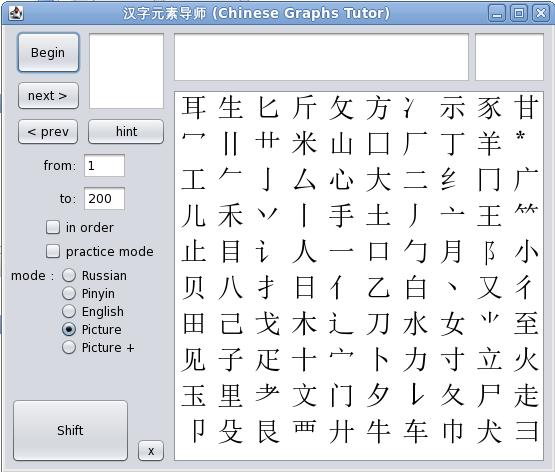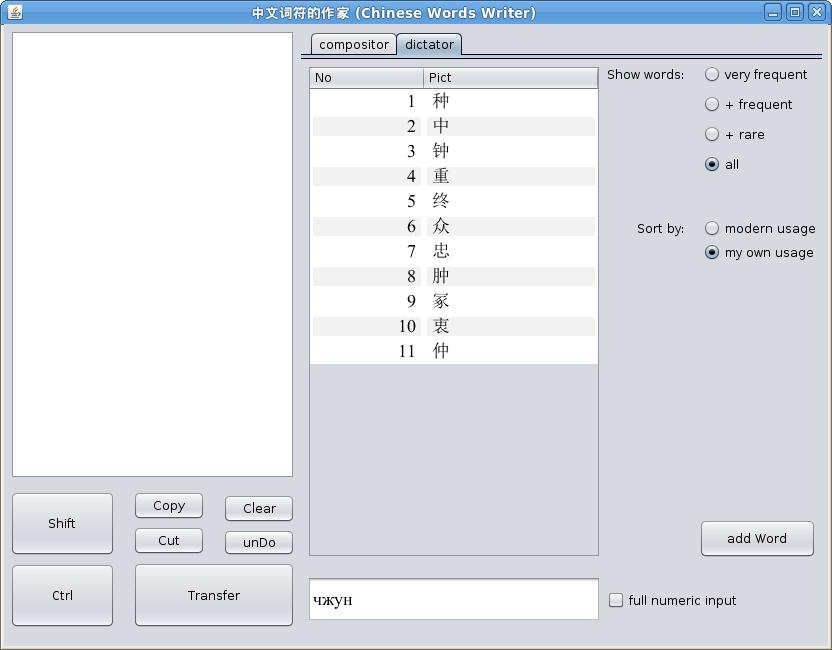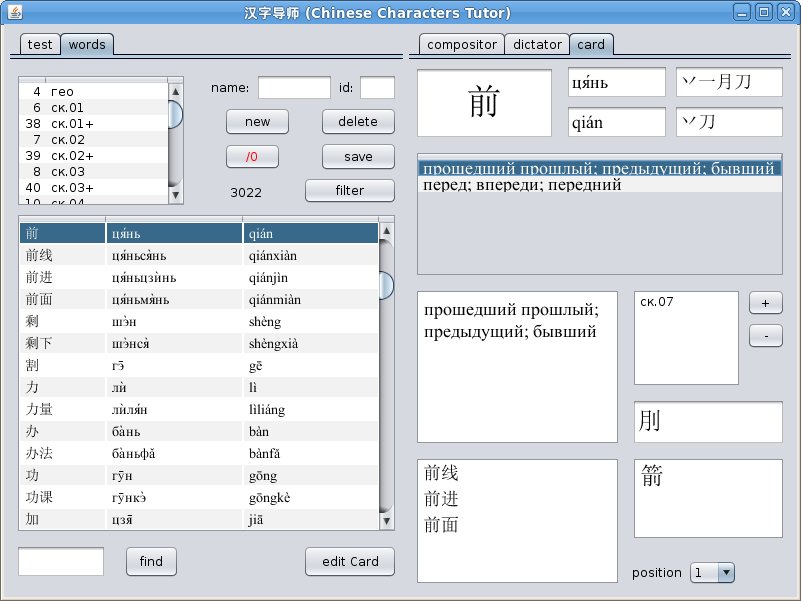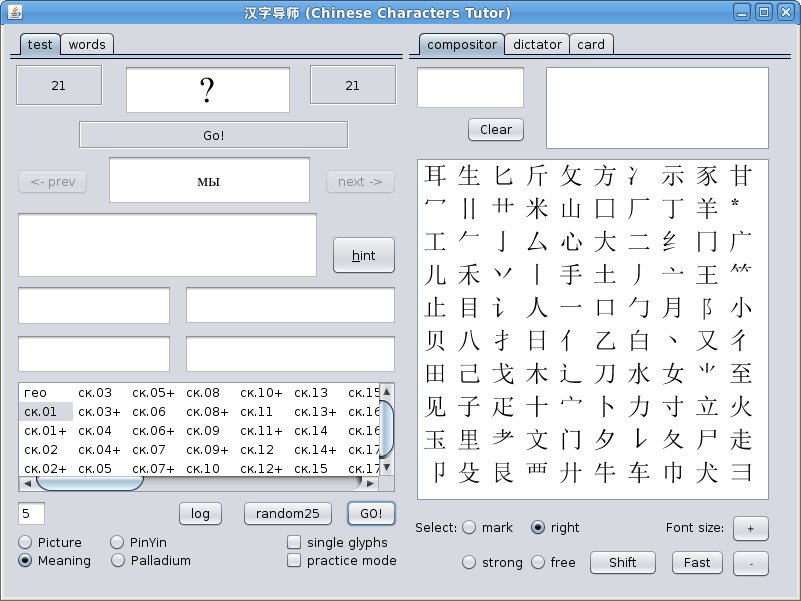If you don't read in
Russian...
Well, You may read it in English (if I can clearly
write in English :).
It's short description of toolkit that allow
anybody easily to master such difficult subject as Chinese Character
writing. But, I think, it's not easy - it's very easy. Just look here.
So now, each Chinese character (let's call it "hieroglyph"
for brevity) consist of some simple characters ("graphs" for
brevity too), for example: hieroglyph 人 ("man" or "person") consist
of one graph 人, hieroglyph 从 (" to join ", apart
from other meanings) consist of two graphs 人, hieroglyph 众 ("crowd")
consist of three graphs 人; as well as hieroglyph 品 ("product")
consist of three graphs 口. And if I'll ask my computer to show me
hieroglyph which consist of three graphs 人, it will show hieroglyph
众, but not 品, isn't it? And what will "say" my computer if I ask it
to show me all hieroglyphs containing graph 人? Ok. It'll show 人, 个,
and 从, and 众, and 病, and many others, and it will be more then 4
hundreds. It's hard to make proper selection from such list. But
it's my computer, and I can to come to agreements with it to show
hieroglyphs in some order. For example, there are only 56
hieroglyphs which contain graph 人 in first position. So, I must
point graph and it position to find "wanted" hieroglyph. The
simplest way to point graph position is input it in right order.
- Show me all hieroglyphs containing graph 氵 in first position. - I
ask my computer.
- In first position graph 氵contains in 352 hieroglyphs. - answer it.
- Ok. But it's too many for fast selection.
- And what's next? - asks me my computer.
- 囗.
- There are 7 hieroglyphs, which do you prefer?
I can select wanted hieroglyph in such a list, but I point last
graph - 人.
- I know only one hieroglyph which has such sequence of graphs: 氵,
囗, 人, - 泅 ("swim").
- Ok. It's what I wanted.
Well, but what can I do with 骤,
for example. It consist of 9 graphs: 马耳又丿丨丶丿丿丿, - in exact such
sequence (we should describe each character in order "from
top-left to bottom-right" as a rule). Should I remember that
terrible sequence and point each graph one by one? No. By good
fortune, in most cases graphs set has some "information
redundancy", or "superfluity". In our case, quite unexpected, for
input hieroglyph 骤 ("unexpected") quite enough to point two first
graphs 马 and 耳. Such short, reduced sequences we'll call "markers".
In most cases marker is sequence of 2 or 3 graphs. Moreover, marker
always begins from first graph of full sequence of graphs, next may
be second or last graph. If marker consist of 3 graphs, it's almost
always first, second and last graphs of common sequence, with very
rare exceptions. Thus, we can formulate common rule: every
hieroglyph can be inputted by pointing three graphs - first,
second and last.
My PC knows markers for 6683 hieroglyphs. If we
look at first three thousands hieroglyphs by frequency usage, we'll
see, that in more then half (69%) of cases quite enough 2
clicks of mouse for input these hieroglyphs, and in 25% of
cases we'll need three clicks. It should say, that in 0,46% cases
we'll need four clicks. It impresses, isn't it? It's not difficult
to remember markers for most frequently used hieroglyphs. But if You
don't want to memorize markers, You may remember a simple rule: "first,
second, last", - it's enough. You'll can input overwhelming
majority of hieroglyphs easily and quickly.
Now I present "short" or "compact" version of
tools (which supposed port it on mobile devices with small screen in
future). It knows 4345 Chinese characters and more then 44 thousands
words consisting of these characters. Total compact version is able
to enter with two clicks of the mouse 82% Character. All of
these characters described by 200 graphs. You can see
full set of graphs with more or less full set of they variants in the following table.
It may seems bored, but it's not difficult to
remember graphs, because you know most of it - it's well known for
You radicals with some changes. I offer for You simple tool for
remembering this graphs. It looks like this (if you have installed
font Palladium):

There are five clear training modes (Picture+
by contrast Picture offers for tutoring and testing not only
main graphs but also their variants,
for example, 乛, ㇆, 乚, ⺄ for graph 乙 ), but I recommend You use "Picture"
or "Picture+" mode. Why? Because it's "image recognition",
and You must to be able to recognize it in hieroglyphs, not to
remember its names. It may be hard for first time, and You may use
names for easy remembering images: 人 - person, 犬 - dog, 火 - fire. It
doesn't matter: "The image is everything, the name is nothing".
Ultimately You should be able recognize images. And I assure You,
that after dozen lessons with Graphs Tutor, You will
remember set of graphs forever and ever :)...
Shift button shows
the second half of the matrix
(the same does Shift key on keyboard). Small
"sticky" button "x" prevents matrix from return into initial
state that allow You easy learn the second half of matrix. There is
no need to describe it more - "sapienti sat". One tip
only. "In order" mode means "in order of frequency usage" (starting from the center), not one by one
in matrix.
If You well know this sequence and positions of
all graphs, You'll have not problems with other tool. And don't be
afraid to try all modes, all variants, it's not possible to spoil
anything :).
Let's go to main tool - WordWriter.

It's also very simple. You select graph on graphs
matrix with mouse click. It appears in graphs window.
Hieroglyphs that contains this graph appear in hieroglyphs
window . Add second graph to change set of hieroglyphs in hieroglyphs
window. And so on. You have to find the hieroglyph you want in
hieroglyphs window and put it into output window
clicking on it. One "trick": if you press Ctrl-key, the first
hieroglyph from hieroglyphs window will be put into output
window (Transfer button does the same). If
check-box Show Words is checked, list of Chinese words that
begin with first hieroglyph in hieroglyphs window, will
appear in word window (right window on pane). It makes
easier input of "long words". Just click on it. Also You may click
on hieroglyph in hieroglyphs window with pressed Num/?
button and You'll see short information about required hieroglyph:
its graphs sequence and its marker.
Selected hieroglyphs set depends on selection
mode, which you may change with selection radio-button.
- Free selection - is the simplest mode, it selects
hieroglyphs that contain chosen graphs in any (random) order.
- Mark selection (default) - the fastest method, it
shows hieroglyphs which contain selected graphs as its
markers.
If You choose mark selection and uncheck
Show Words chek-box and Your graph sequence correspond to
just one hieroglyph, it will be placed into output window
immediately (and this happens quite often when mark
selection turn on). Located below the check-box reduce matrix
(enabled by default) provides the mode of reduction of the
matrix, where after entering a graph, the matrix remain active
only "allowed" graphs, i.e. those which may occur at the next marker
position. This reduces the likelihood of errors and random typos.
Test it all, and You'll understand all.
The purpose of Copy and Cut and Clear
buttons is obvious :). The first two put text from output window
into paste buffer and the last clears output window. You may use
text from paste buffer anywhere you want.
The dictator pane intended for
phonetic input. It's not interesting for me, but You can use it if
You want...

It's not simple, it's very simple: you input
syllable in pinyin (or in palladium, as on picture) and finish it by
number - "tone indicator". If your syllable correspond to just one
hieroglyph, it will be placed into output window
immediately, if not, you'll see a set of corresponding hieroglyphs
in hieroglyphs table. There are three "ways and means" to
select the desired hieroglyph:
- navigator-keys + enter,
- mouse click,
- numeric key.
If table contains ten or less rows, simply press necessary digit-key
("0" means "10" in this case), otherwise, press and hold
Alt-key, input required row number and after that release Alt-key.
Try it and you will like it.
If you want input two- or more syllabic word, no
need indicate tone, finish input by space (thus, "zhongguo + space"
immediately will give "中国" in output window). It's very
convenient way to input polysyllabic words. If you don't like it,
you may check full numeric input field, but in this case you
have to input digital tone indicators and finish each input (even
one-syllabic) by space. You may input initial part of syllable, one
or more letters, add percent sign "%" and press space - WordWriter.
shows all hieroglyphs, that pronunciation begins with your sequence.
Punctuation marks inputted in bottom (input) window place
into output window. And to crown it all GlyphsWriter
knows how to input Chinese punctuation marks (、。「」 ) - simply hold
Alt-key and type ",", ".", "<" or ">".
You can add a new word by clicking addWord,
if WordWriter "don't know" it. Just fill out all form fields and
click Save.
And (what is more important for beginners)
you can use WordWriter for input unknown
hieroglyphs, when You don't know its pronunciation, to load them
into any computer dictionary you use. Although, for Russian users I
have Chinese-Russian dictionary with both
compositional and phonetic input , and it's not hard to
implement "Chinese-any language" dictionary :)...
That's all.
- But... How can I learn this "awful markers"? Do
I need each time to press Shift-key and click mouse for each found
hieroglyph to see markers? It's not convenient...
- No, no, no.
Next tool designed for make easier learning
"awful markers" - GlyphTutor.
To "play this game", you must prepare cards
for lessons (words pane).

First of all, You need to prepare list of
lessons. Don't pay attention to strange Cyrillic characters - it's
example only, and You can replace them to anything. You can add,
change name, or delete any lesson. Name is text field and
You may write anything into this field: "food", "numbers" "clothes"
and so on. Don't forget press Save button if You change anything.
Only two tips: button "/0" ("division by zero") set number of right
answers during the test for chosen lessons to zero; filter sticky button filters words table
on the appropriate lesson, repeated
pressing remove filter.
I have prepared for you 48 lessons based on educational texts with Russian
translation. You are free to simply translate them into English or
prepare their cards on the basis of any English-Chinese dictionary.
Find required hieroglyph in words table
with compositor or dictator (see description
of WordWriter.), or paste hieroglyph into find
field and press find button, then fill its card by edit
Card button.

Write meaning of hieroglyph and press Save
Button. You can make new word or delete unnecessary
one.
Then it's time to start tutoring (test pane).

Choose lesson in bottom lessons window
(you may choose several lessons by mouse and Ctrl or Shift
key ), check practice mode, click Go! and begin
training. You may pass the lesson by next -> and <-prev
buttons. The rest depends on you. If are you satisfied with lesson,
uncheck practice mode and begin test.
Depending on indicated mode, Tutor can present as a
question picture (hieroglyph itself), meaning of
hieroglyph, or pronunciation (in PinYin or Palladium).
If You plane learn hieroglyph by picture or pronunciation, You no
need fill meaning for each hieroglyph. During test you may
click hint button, the Tutor outputs picture of hieroglyph,
its graphs sequence and marker, but this answer won't count. You may
also see little and simple log with your current mistakes
(if any). Little bottom window with digit (on default = 5) determine
number of right answer, after that Tutor don't presents hieroglyphs
for testing.
More complicated Selection section
(see description of WordWriter.) make
easier search unknown hieroglyphs, especially in preparing cards. In
addition to the above, the most interesting selection mode - right
selection. This mode requires special explanation. "Ingenious" and
"convoluted" algorithm of this selection built thus, that the "most
probable candidate" appears in hieroglyphs window first. Do
you remember "Ctrl-trick"? You indicate graphs in certain
order and, when required hieroglyph appears in first position, hit Ctrl.
That's all. I assure you, if you will follow the simple rule: "first,
second, last", - i.e. will indicate first, second and last
graphs from graphs set of required hieroglyph, you will need only
two clicks with probability about 75 %. Strong selections -
system will select and show You exactly those hieroglyphs, in which
graphs occur in exactly that sequence which You indicate in graph
window.
That's all.
You can download these "marvellous tools" here:
WordWriter.
Tutor (both GraphTutor
and GlyphTutor)
and use them (or don't use) as you want
:)...
Please feel free to contact me if you need: support@poutko.ru.
Sincerely Yours
B. Poutko.
The End.
Sorry, no, not the end. Now You can test on-line
version of similar tools: reduced
Writer and simple Chinese-English dictionary with
Compositional Input method only, without phonetic input. Short
description lies here.
Now the end.
...while :)..





